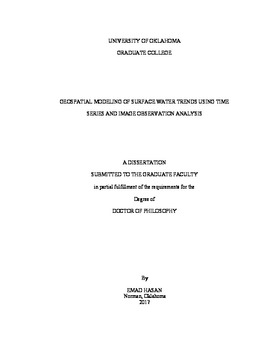| dc.description.abstract | This study addresses the impact of climate change on the Nile River Basin (NRB) and its downstream delta, the Nile Delta of Egypt. The NRB region undergoes a huge fluctuation in precipitation and temperatures from year-to-year. Via a combination of multi-scale satellite remote sensing, model reanalysis, and land surface model information, this study evaluates: 1- how this variation in precipitation and temperature affects Nile River flow, 2- to what extent future sea level rise (SLR) could impact the Nile Delta of Egypt, and 3- how historical variations in the El Niño Southern Oscillation (ENSO) signal are responsible for fluctuations in water storage in the basin.
To answer these questions, a comprehensive water budget equation valid under different climate scenarios was formulated. Next, the variation in precipitation and temperatures was used to calculate the elasticity (reliance) of the Nile River flow to climate change. Third, a merger between remotely-sensed digital elevation models and in situ elevation measurements was used to estimate the future SLR impact in the Nile Delta.
The study results indicate regular surface flows are maintained when basin-integrated storage changes (expressed as a depth) increase by less than 60 mm. Meanwhile, decreases in storage change of more than 40 mm subject the basin to severe drought conditions. The Nile River flow is highly sensitive to variations in precipitation and temperature. A 10 percent increase in precipitation results in a 20 percent increase in surface runoff. A -0.5°C change in temperatures results in a 5 percent increase in surface runoff. SLR is an imminent threat to the Nile Delta’s communities and land; potential impacts are intense but confined to coastal areas. For instance, a 1-m SLR will inundate about 580 km2 (6 percent) of the total land area, and would necessitate the relocation of approximately 887,000 people. The reconstruction of historical basin storage changes indicates that there is a connection between the ENSO and the long-term variation in NRB water storage. Specifically, strong El Nino events are associated with droughts in the NRB and strong La Nina events are associated with floods. | en_US |
